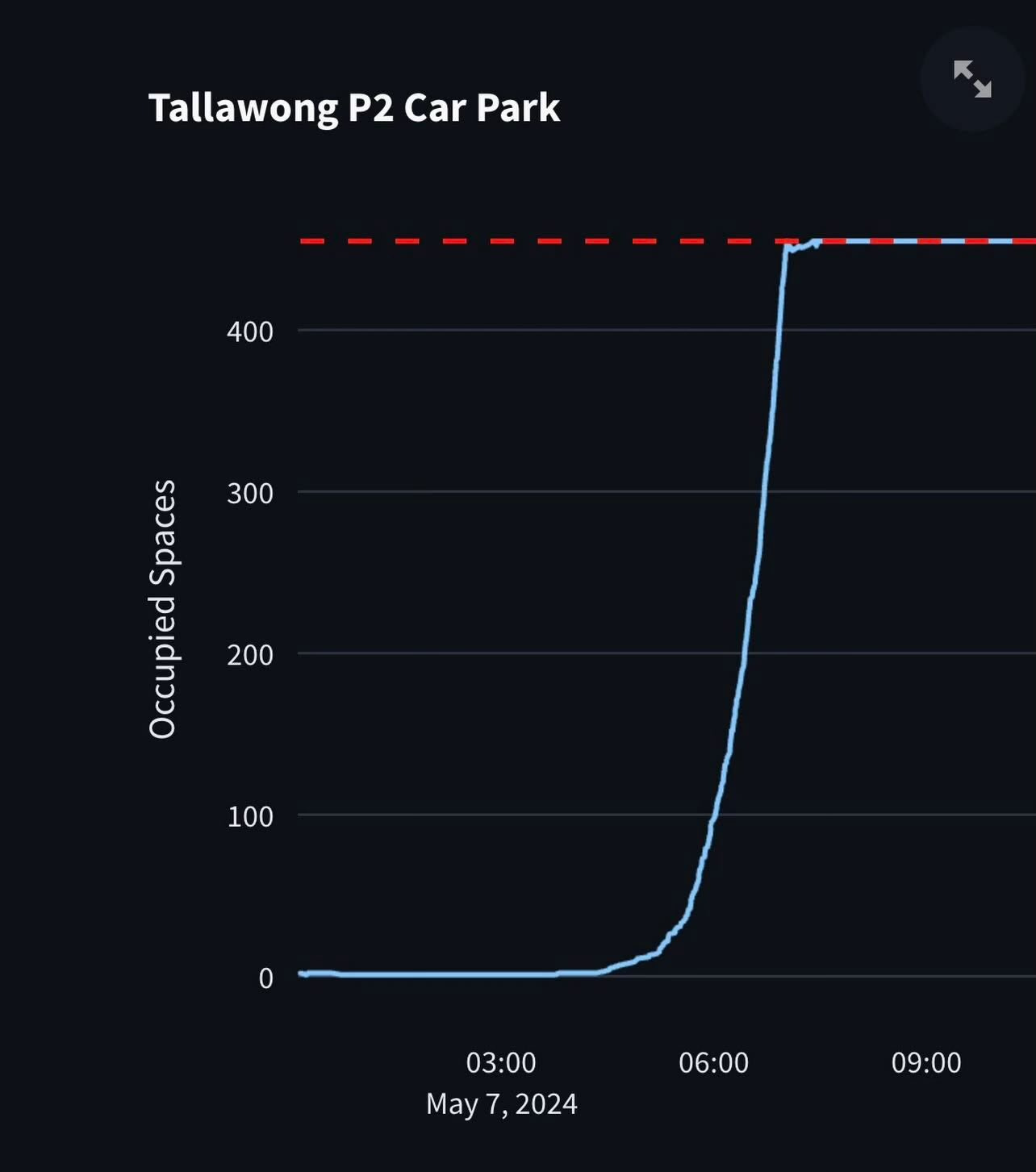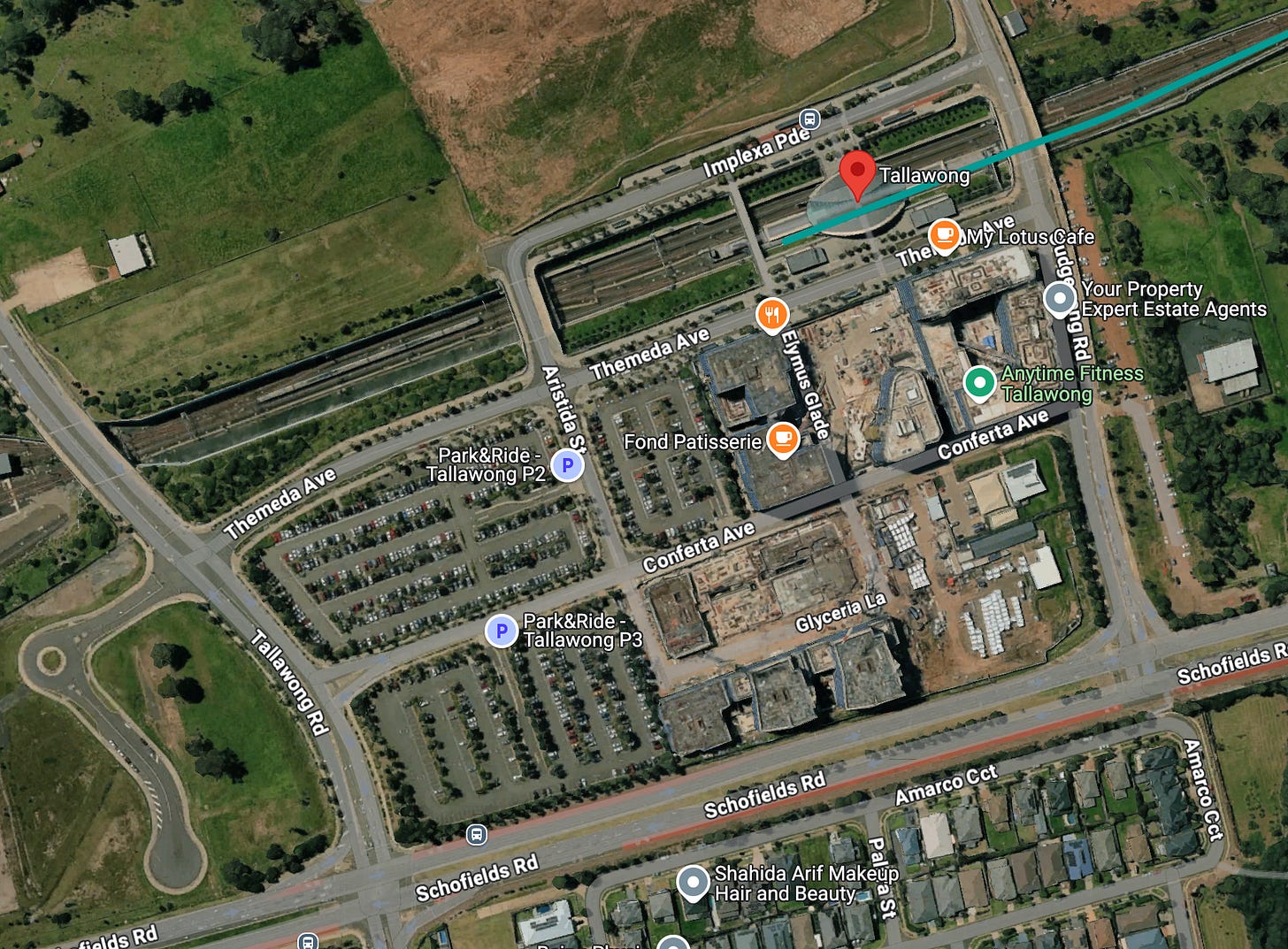Stop building car parking at train stations!
The case for train station car parking doesn't stack up, and all you need to prove it is some simple arithmetic.
I’m always talking about the foolishness of train station car parking (a new one seems to get opened in Melbourne almost every week, ironically by the “Minister for Active Transport”) but get the same questions and args in response every time.
So I’m going to lay the full case out here once and for all.
The core problem: Space efficiency
Cars take up a lot of space. They are uniquely space inefficient, which is why they are unique in the congestion they cause.
At a train station, this is particularly acute, because in contrast, trains are very space efficient. Even a very large car park can only fill a fraction of a single train.
The new car park at Frankston Station, for instance, has 500 car parks. The X'Trapolis 2.0 trains that will run on this line from next year, have a total capacity of 1241 (443 seated, 798 standing).
If we assume that trains run every 10 minutes from 6am to midday, this car park can fill at most 500 / (1241*36) = 1.1% of total capacity leaving the station.
Of course, Frankston is only one station, and there are many stations along the line. But even 10 similarly generous stations would only fill 10% of total morning capacity.
Even then, we can’t assume that each of these passengers is a boost to ridership.
Many parkers would have taken the train anyway
Many people say that train station parking boosts ridership by allowing those for whom walking/biking/PT to the station is impractical to still get to the station - without it, they would drive all the way into town instead.
But that’s an overly rosy assumption - many people parking at the station will be people who do live close by, otherwise could easily have got there another way, but drove simply because the free parking was available.
So many of the parks won’t result in a mode shift from long drive to short drive plus train. Instead, that building that park will merely create increased local car traffic - in other words, a mode shift from short walk/bike/PT plus train to short drive plus train.
Even worse than regular parking
Car parking is just generally a bad thing when there is far too much of it, as there is in Melbourne’s case. But at least typical high-demand parking usually has time restrictions and/or payment so that it turns over relatively frequently and one car doesn’t hog a spot all day.
But this is not possible with train station parking. These parks are aimed at commuters. Commuting is invariably an all-day thing, so a single commuter car park boosts ridership by at most 1 rider per day (unless commuters carpool, which most won’t).
Unless you leave very early, there won’t be a car park available
One arg you hear in response to this is that even if station parking is a poor way to boost ridership, perhaps we can argue that it’s still good to make the choice available.
Unfortunately, the choice still won’t be available, because station car parking in high demand areas fills up extremely quickly and early in the morning. If you need to a park after the station is full (which is most of the day), then you’re out of luck.
Sydney’s PT car parks have an API which allows precise tracking of this - the output of which you can see in this chart made by somebody on reddit (can’t find the original post, please get in touch if it was you for suitable credit).
Tallawong is a popular station on Sydney’s new metro line. You can see that car parks start rapidly disappearing after 6am, and are gone by about 7am.
(And a train with more capacity than this entire car park leaves this station about every 4 minutes.)
Unless you live the kind of life where you can leave for work at 6am, forget about it. Got kids to drop to school first? Forget about it.
Some underpopulated/underutilized stations may be less congested - but as soon as those stations have more catchment population and services, the same problems will occur.
And the more the line frequency increases, the less of a percentage ridership boost the car park can offer.
No reduction in local congestion or necessity of car ownership
When car parks are available, the cars driving to/from those car parks still create local morning/evening peak congestion on local roads from commuters going to/from the station.
In the morning, this will be reduced by the car parks becoming full early, although many people will try driving to another station, or drive the entire way.
And leaving a car at a station all day still requires owning just as many cars as a purely car-based commute, so building these car parks doesn’t reduce car dependency from the perspective of ownership.
Poor land use at the station
Let’s look at the aforementioned Tallawong Station. In the newly developed land at the station, we can see that about as much land has been dedicated to car parking as to housing.
So building the car parking makes the area around the station more car-dependent and congested, reduces the amount of housing available, and lowers the catchment population of the station via the reduced housing and sprawl.
All of this further reduces ridership rather than increasing as supposedly intended.
Perverse pricing - parking is free while fares cost
In spite of being expensive, these car parks are given away for free use. Meanwhile, those who take buses, trams and short train trips generally have to pay fares which are very expensive on a per-km basis.
The person who drives to the station gets free, dedicated all-day use of an extensive asset, while the person who buses to the station gets a mere bus ride, while both pay the same total.
Effectively, non station parking users are subsidizing car users to get to the station much less efficiently (and to slowing down buses along the way because the buses usually have to spend time sitting in car traffic thanks to lack of bus lanes).
This is just intuitively unfair, and on a purely practical level increases car overuse (that is, car use even when a bus would have been just as convenient).
A money sink for government
Building expensive infrastructure and then giving it away for free is obviously terrible for government’s finances. Frankston’s car park cost around $170k per car park to build, with ongoing maintenance costs on top of that.
When we compare this to building housing next to stations instead, we see just what a terrible idea it really is. If the government had paid a developer to build housing at the station instead, it would instead be making money from the sale or ongoing rent of the apartments, and be able to use that money to fund better walking, bike and bus infrastructure to get more people to the station.
In other words, this would result in more ridership AND more money.
Instead, we’re draining public coffers for the purposes of less ridership and more car dependency.
Why aren’t the private sector building station car parking?
If the government didn’t build station car parking, but there was still high demand for it, private interests are quite capable of building it. There’s no need for governments to compete in catering to this inefficient and unworkable preference.
And of course, it’s still possible to drive to a station and simply park a little further away in a regular parking space or car park.
The case for station car parking is so poor that anybody looking at it rationally can see that it is a stupid idea. However, cars exist in a special category in many people’s minds where only the upsides matter, and the downsides magically don’t exist. Politicians who like being driven around and like attending ribbon-cutting ceremonies are particularly partial to this sort of thinking.
The solution - housing, walking, biking, buses
Look at the streets surrounding any station with a large car park and you’ll see why people drive to the station even from nearby - the housing is sprawled, the streets are car-dominated and unwalkable, bike lanes and paths are nonexistent/dangerously inadequate, and buses are infrequent.
The solution is simple, the government owns lots of great land at and around train stations. Put housing it, make money from that, use that money to improve efficient ways of getting to the station.




Agreed. The land use accessibility void (carpark) around stations is like a form of siege, blockade or strangulation. It forces motor trips because the station is not an origin or destination in itself. You have to go elsewhere for kindy, education, food, shops, services, entertainment etc. I've often thought that leasing the land around and above stations could help pay for public transport services, where car storage is 100% overhead liability. Invest in paths not carparks.
A few years ago a multi story structure started to be constructed near Springfield station south of Brisbane. I recall seeing it thinking "Yay more housing supply near a train station, what a great idea in a housing and cost of living crisis". Alas, it became storage supply for machines not housing supply for people.
Bike hire works in the wrong direction. Reversing the model could help public transport.
I don’t want to leave my personal bike at the train station due to theft.
Why not hire a bike at the station and take it home for the night, easy to plug in and recharge on a 10amp circuit, then return it next morning?